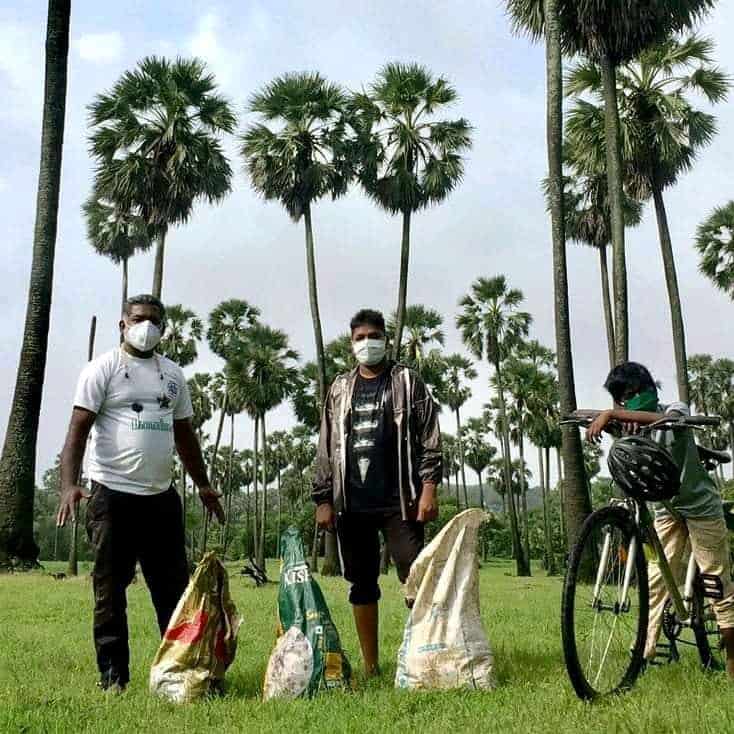For the third year in a row, Rev Godson Samuel, 46, a Christian pastor has been collecting Palmyra palm seeds from Aarey during the monsoons and distributing it for planting. This year, he has already helped gather and distribute around 7000 seeds in Mumbai along with volunteers from citizen groups like Rewilding Aarey. This is apart from the 13,000 Palmyra seeds that he sourced from others for plantations in other parts of Maharashtra.
Godson wants to convert Mumbai into a ‘Palm Bay’ by encouraging growing over one lakh Palmyra plantations over the next few years. His passion for Palmyra is evident in every corner of his house, the wooden crucifix made up of palm wood on his walls, palm leaf art neatly framed and a cupboard full of palm products like baskets, caps, palm-leaf fans etc.
Originally from Kanyakumari and having settled in Mumbai since 2007, Godson feels that Mumbai must take to Palmyra plantations to fight environmental and climate change concerns plaguing the city, like landslides, floodings, depleting groundwater levels and increasing forest fires.
Read more: Why Mumbaikars are getting angrier about tree felling
Extensive research has convinced Rev Godson that Palmyra could serve as a simple, cheap solution to restore ecological balance. The tree roots serve as natural soil aquifers; its tap roots spread far to pull up the groundwater and stock it for future use. The roots also gets a strong hold on to the soil to withstand strong winds, thus preventing soil erosion. They also serve as wind arresters during cyclones.
The plant can also aid livelihoods by creating economic upliftment opportunities, especially for traditional Palm tree climbers.
How is the Palmyra tree useful?
Palmyra is one of over 2000 species of Palm like Date, Coconut or Areca palms, that are grown all over the world. This species is believed to have originated somewhere between Africa and South-East Asia.
Palm fruit, known as ice apple or tadgola in Marathi, is relished in its jelly form. The palm fruit sap is converted into the popular drink Toddy, earning it the name Toddy palm. The plant is also used to make palm sugar and jaggery. Its fleshy sprouts or tubers are edible and consumed as a vegetable. Its leaves are used for making household articles like baskets, bags, brooms, mats, caps and decorative articles.
Not so long ago, the poor would use the palm leaves for roofs and the stem as supporting pillars. Its wood was also used in making boats. In the olden days, palm leaves were used for manuscripts. Many ancient Palmyra manuscripts are preserved in various museums. Palm leaves were also used as packaging material especially for packing spices carried in ships along the coast. The leaves were also used for maintaining accounts of trade transactions.
Palmyra tree plantations suit Mumbai best as they occupy less space and require almost no maintenance. The plant can grow in all kinds of terrain – from dry, wet, coastal to rocky. It doesn’t even need to be dug deep to plant; a pit just enough to cover the seed is enough. Unlike say coconut, which needs good nourishment initially, Palmyra sustains itself on groundwater its entire life and doesn’t need to be watered even in the initial stages.
Since its nature is that of a wild plant, it is resistant. However, it is a slow-growing tree and it takes about a year just to rise above the ground and about 10-15 years to grow fully. From then on it can live for about 120 years.


Rewilding Aarey team roots for Palmyra but challenges remain
The Rewilding Aarey team looks at Palmyra as a natural defence against perennial forest fires. Since its fibrous root runs deep underground, Palmyra manages to grow back successfully even if it catches fire. This survival trait of the Palmyra could help fight the forest fires that have been plaguing Aarey forest of late, believes Sanjiv Valsan, organiser of the Rewilding Aarey group.
Unlike last year when their plantations involved many different kinds of native species like Peepal, Banyan, Jamun etc, this monsoon the group chose to focus mainly on Palmyra plantations and planted around 1400 seeds along the fire-prone zones. They are also working to execute Palmyra plantations in other parts of Mumbai in coordination with the Brihanmumbai Municipal Corporation (BMC).
Read More: “Aarey is the most abused and exploited land mass in Mumbai”
The tree throws its seeds down only during the monsoons, and Godson needs more volunteers to gather them. “Over 10,000 seeds fall on the ground but we aren’t able to collect and put it to use due to lack of volunteers,” says Rev Godson. The seeds are big and weigh around a kilogram per helping, which means that collecting them in bulk and lugging them on a two-wheeler becomes difficult. The Reverend also need sponsors for boxes to distribute Palmyra seeds.
In 2019, Rev Godson had distributed over 1000 seeds free to drivers of vehicles on Aarey Road. He is also looking at avenues to display and propagate artefacts and articles made from palm.
Godson’s passion for Palmyra made him undertake an 18-day bike tour from Mumbai to Kanyakumari to document and map the Palm route in peninsular India, which he compiled in a Tamil book titled Panaimara Salai (Palm route) in 2018. Palmyra, he believes, must have sustained entire civilisations akin to riverine civilizations due to its ability to provide food through the year and attract large numbers of birds and insects.
You can also participate in Project Palmyra
One can volunteer for seed collection and plantation programs during the monsoon season. You can also help participate in the Palm tree awareness programs conducted by Rev. Godson, who can be contacted on mtcaarey2020@gmail.com.